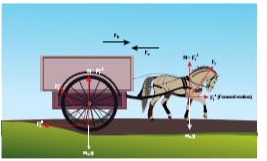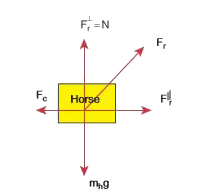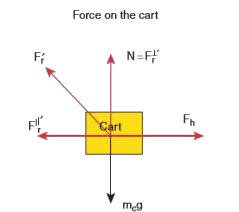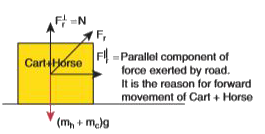Consider a horse attached to the cart which is initially at rest. If the horse starts walking forward, the cart also accelerates in the forward direction. If the horse pulls the cart with force Fh in forward direction, then according to Newton’s third law, the cart also pulls the horse by equivalent opposite force Fc=Fh in backward direction. Then total force on ‘cart+horse’ is zero. Why is it then the ‘cart+horse’ accelerates and moves forward?
This paradox arises due to wrong application of Newton’s second and third laws. Before applying Newton’s laws, we should decide ‘what is the system?’. Once we identify the ‘system’, then it is possible to identify all the forces acting on the system. We should not consider the force exerted by the system. If there is an unbalanced force acting on the system, then it should have acceleration in the direction of the resultant force. By following these steps we will analyse the horse and cart motion.
If we decide on the cart+horse as a ‘system’, then we should not consider the force exerted by the horse on the cart or the force exerted by cart on the horse. Both are internal forces acting on each other. According to Newton’s third law, total internal force acting on the system is zero and it cannot accelerate the system. The acceleration of the system is caused by some external force. In this case, the force exerted by the road on the system is the external force acting on the system. It is wrong to conclude that the total force acting on the system (cart+horse) is zero without including all the forces acting on the system. The road is pushing the horse and cart forward with acceleration. As there is an external force acting on the system, Newton’s second law has to be applied and not Newton’s third law.
The following figures illustrates this.

If we consider the horse as the ‘system’, then there are three forces acting on the horse.
(i) Downward gravitational force (mhg)
(ii) Force exerted by the road (Fc)
(iii) Backward force exerted by the cart (Fc) It is shown in the following figure.

Fr- Force exerted by the road on the horse
Fc Force exerted by the cart on the horse
E⊥r- Perpendicular component of Fr=N
F∣∣r- Parallel component of Fr which is reason for forward movement.
The force exerted by the road can be resolved into parallel and perpendicular components. The perpendicular component balances the downward gravitational force. There is parallel component along the forward direction. It is greater than the backward force (Fc) . So there is net force along the forward direction which causes the forward movement of the horse.
If we take the cart as the system, then there are three forces acting on the cart.
(i) Downward gravitational force (mcg)
(ii) Force exerted by the road (Fc)
(iii) Force exerted by the horse (Fh)
It is shown in the figure

The force exerted by the road (veFr) can be resolved into parallel and perpendicular components. The perpendicular component cancels the downward gravity (mcg) . Parallel component acts backwards and the force exerted by the horse (→Fh) acts forward. Force (→Fh) is greater than the parallel component acting in the opposite direction. So there is an overall unbalanced force in the forward direction which causes the cart to accelerate forward.
If we take the cart+horse as a system, then there are two forces acting on the system.
(i) Downward gravitational force (mh+mc)g
(ii) The force exerted by the road (Fr) on the system.
It is shown in the following figure.

(iii) In this case the force exerted by the road (Fr) on the system (cart+horse) is resolved in to parallel and perpendicular components. The perpendicular component is the normal force which cancels the downward gravitational force (mh+mc)g. The parallel component of the force is not balanced, hence the system (cart+horse) accelerates and moves forward due to this force.
Related Playlists
- BOOK - NCERT TAMILCHAPTER - LAWS OF MOTIONEXERCISE - EXERCISE ( I. Multiple Choice Questions)15videos
LAWS OF MOTION
- BOOK - NCERT TAMILCHAPTER - LAWS OF MOTIONEXERCISE - EXERCISE (V. Numerical Problems)14videos
LAWS OF MOTION
- BOOK - NCERT TAMILCHAPTER - LAW OF MOTIONEXERCISE - EXERCISE (ADDITIONAL EXERCISE)17videos
LAW OF MOTION
- BOOK - NCERT TAMILCHAPTER - MECHANICAL PROPERTIES OF FLUIDS EXERCISE - EXERCISE45videos
MECHANICAL PROPERTIES OF FLUIDS
Similar Questions
When a horse pulls a cart, by Newton's III law the cart also pulls the horse with equal and opposite force, then how does the motion of horse, cart and system takes place?
View SolutionA force F=2t2 is applied to the cart initially at rest. The speed of the cart at t = 5 s is -
 View Solution
View SolutionPut the cart before the horses
View SolutionWhen a horse pulls a wagon, the force that causes the horse to move forward is the force
View SolutionWhen a horse pulls a cart, the force that helps the horse to move forward is the force exerted by
View SolutionWhen a horse pulls a cart, the force that helps the horse to move forward is the force exerted by
View SolutionWhen a horse pulls a cart, the force which is responsible for the movement of cart is
View SolutionWhen a horse pulls a wagon, the force that causes the horse to move forward is the force
View SolutionWhen a horse pulls a wagon, the force that causes the horse to move forward is the force
View SolutionWhenever a horse pulls a cart, the force helpful in the movement of the horse is the force exerted by
View Solution

